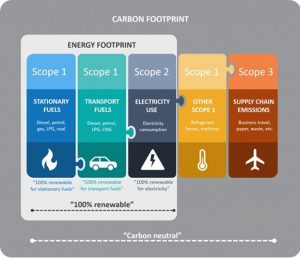It is not always clear what carbon neutrality and 100% renewable energy mean. Below, we define these targets and talk about the difference between your energy and carbon footprint.
The difference between your energy and carbon footprint
Your energy footprint relates to your business’ energy consumption. For most organisations, ‘energy’ encompasses not only electricity but also stationary energy and transport fuels. Examples of stationary fuels are natural gas, diesel for generators, and LPG for forklifts. Examples of transport fuels include diesel, petrol, and LPG that power your fleet.
A carbon footprint is the sum of your emission sources, a big part of which is your energy consumption. You can develop a narrow carbon footprint of emissions that happen at your place of business (Scope 1) and the emissions associated with electricity consumption (Scope 2). Alternatively, you can develop a wide carbon footprint which also includes emissions in your supply chain, upstream and downstream, (Scope 3).
A carbon footprint is usually broader than your energy footprint. You can see in Figure 1 that an energy footprint is a subset of a carbon footprint. From a carbon accounting perspective, your energy footprint relates to your Scope 2 emissions and to some of your Scope 1 emissions.

Figure 1: The difference between your energy footprint and carbon footprint and claims for 100% renewable energy and carbon neutrality
What is carbon neutrality?
Carbon neutrality (or zero net emissions) is reached when all emission sources in your defined boundary are zero. This is demonstrated in Figure 1 in the bottom line. Ideally, your defined carbon footprint boundary encompasses as many emission sources as possible so that your claim for carbon neutrality is credible.
You can reach carbon neutrality by:
- Reducing your emissions onsite through energy efficiency or by installing solar PV
- Building or purchasing renewables offsite, and by
- Offsetting the rest of your emissions through the purchase of carbon offsets
What is 100% renewable energy?
You are 100% renewable when the amount of renewable energy produced is equal to or more than what is consumed. In most cases, people associate only electricity with ‘100% renewable’. However, as you can see in Figure 1 ‘energy’ can encompass stationery and transport fuels as well. So, to be truly 100% renewable, you would have to include these fuels. While it is relatively straightforward to reach 100% renewable electricity, it is more difficult to achieve 100% renewable energy for stationery and transport fuels.
To avoid doubt if your real objective is to green your electricity supply, you can define your target to be ‘100% renewable electricity’. You can reach this goal by:
- Implementing onsite solar PV
- Building your own mid-scale solar farm or solar/wind farm in partnership with others
- Buying renewables (e.g., through a corporate Power Purchase Agreement)
- Utilise the latest technologies to procure green power via tokenisation
Conclusion
Carbon neutrality and 100% renewable energy are two different targets. Technology is speeding up the attainment of these goals and helping reduce the cost of achieving them, in many cases by applying the correct solutions organisations can save money and achieve carbon neutrality. To be a leader in climate change, your organisation should strive towards a renewable energy target as your impact will be much greater.
It is possible to reach 100% renewable energy AND carbon neutrality. Microsoft has been achieving both since 2014. You can also pursue both targets in a staged approach. As an example, you could aim for 100% renewable electricity in the first instance, followed by carbon neutrality in the medium term, followed by 100% renewable energy in the long run.
Obviously one of the major constraints is the costs involved to achieve these targets, however, technology is moving fast and making it more attainable with commercial returns. Innovative blockchain technology now makes it possible for businesses to match their electricity usage with locally-sourced renewable energy directly from specific generators.
Mojo Power have teamed up with blockchain-based green energy experts WePower to offer businesses access to this new technology and competitive energy prices. Because going renewable shouldn’t have to cost the earth.
The Mojo Marketplace platform can link your company’s energy consumption to the renewable generation projects of your choice. The electricity generated by these projects is tokenised so it can prove how much renewable energy each project sends to the grid and match this to your business’ energy usage.
The electricity is tokenised so you get genuine, matched renewable energy at competitive prices that is easily traceable and auditable.

